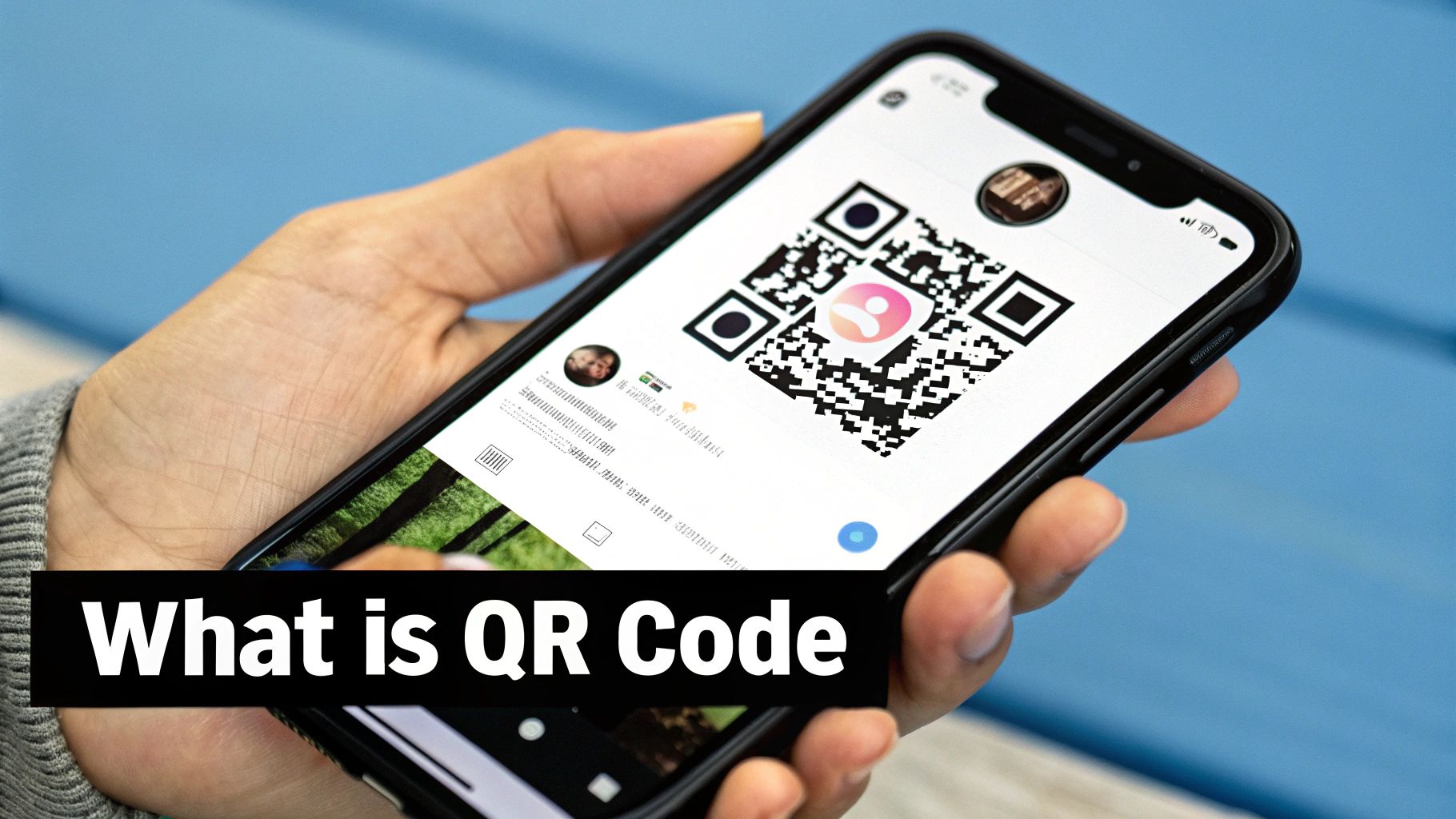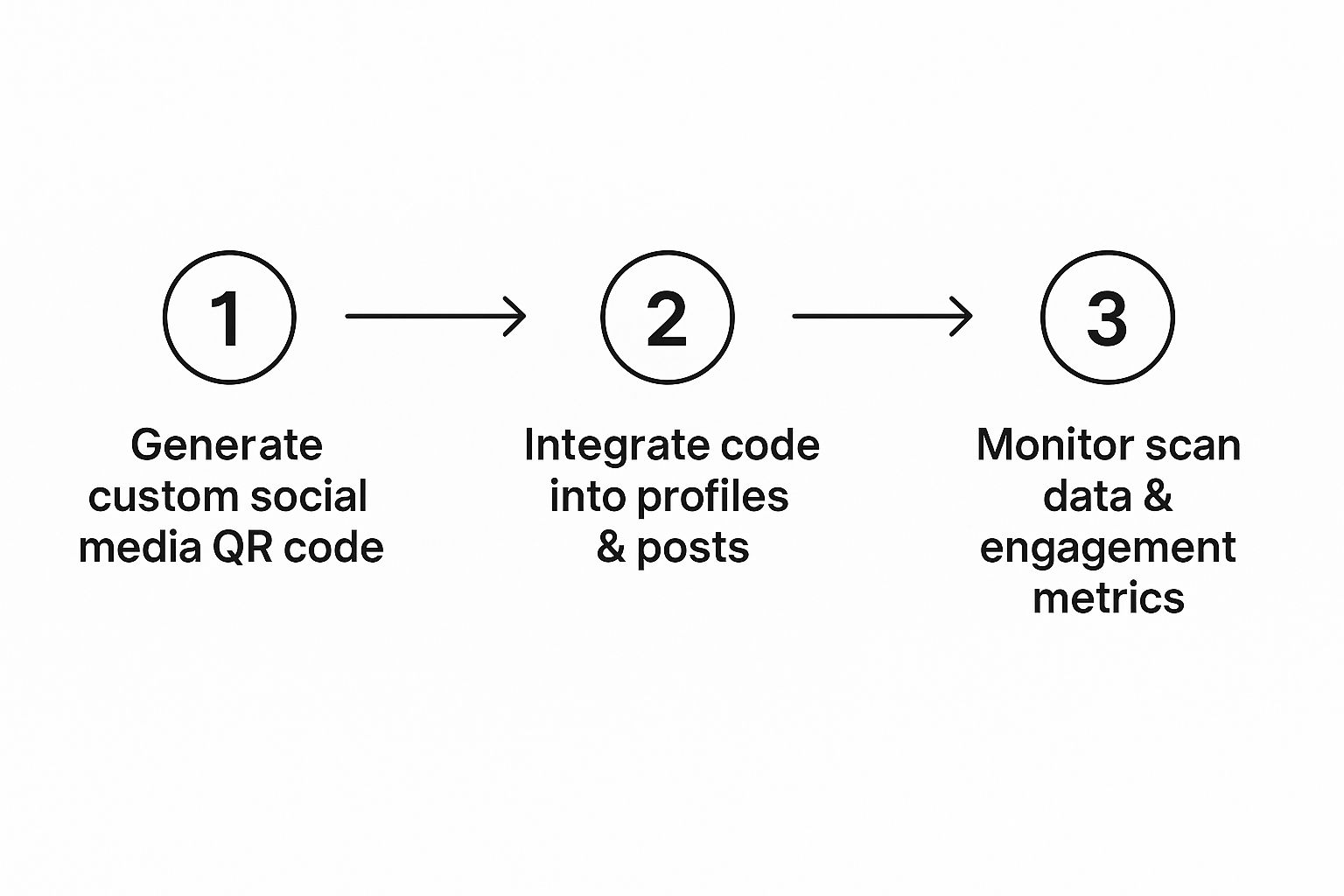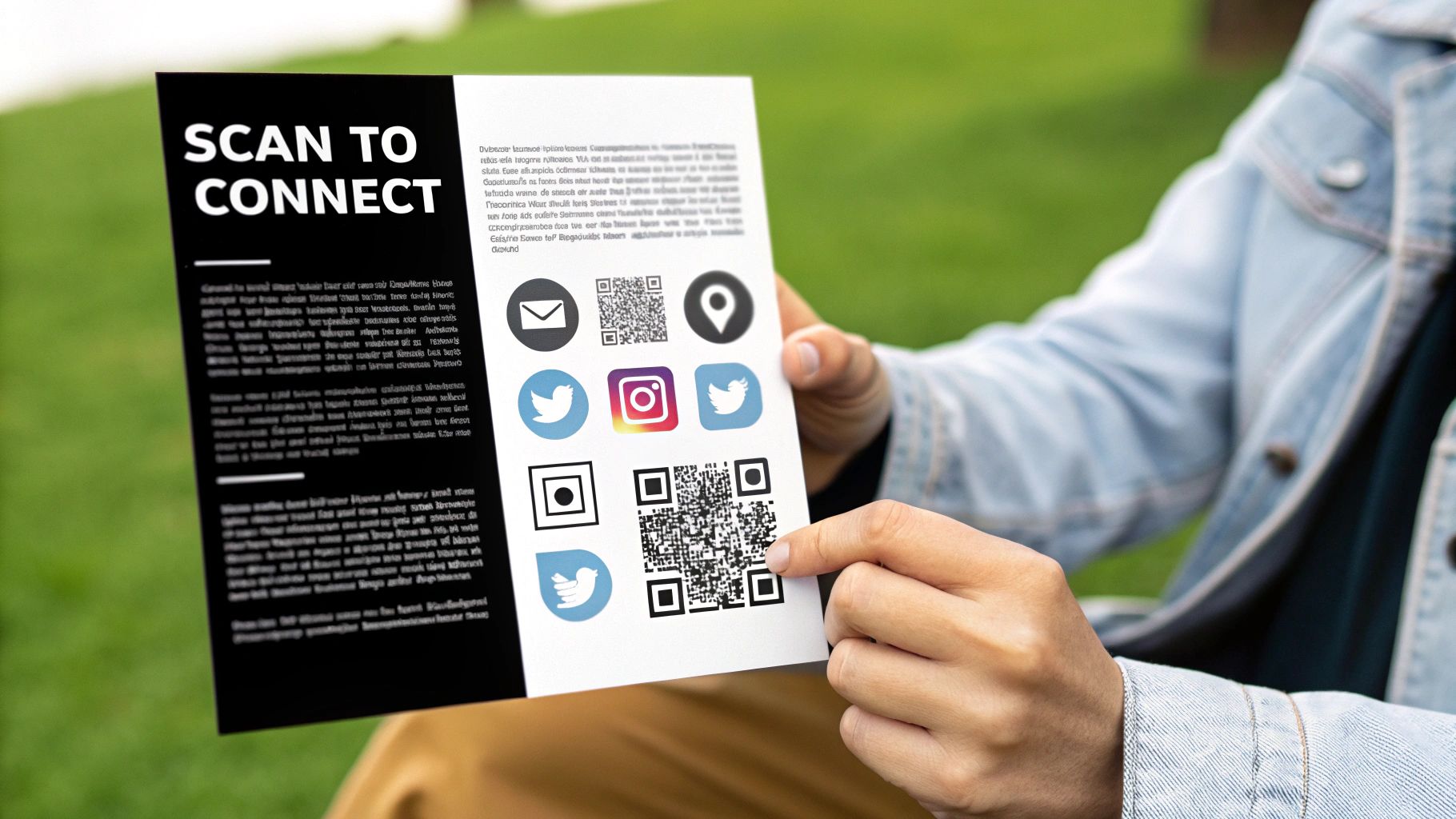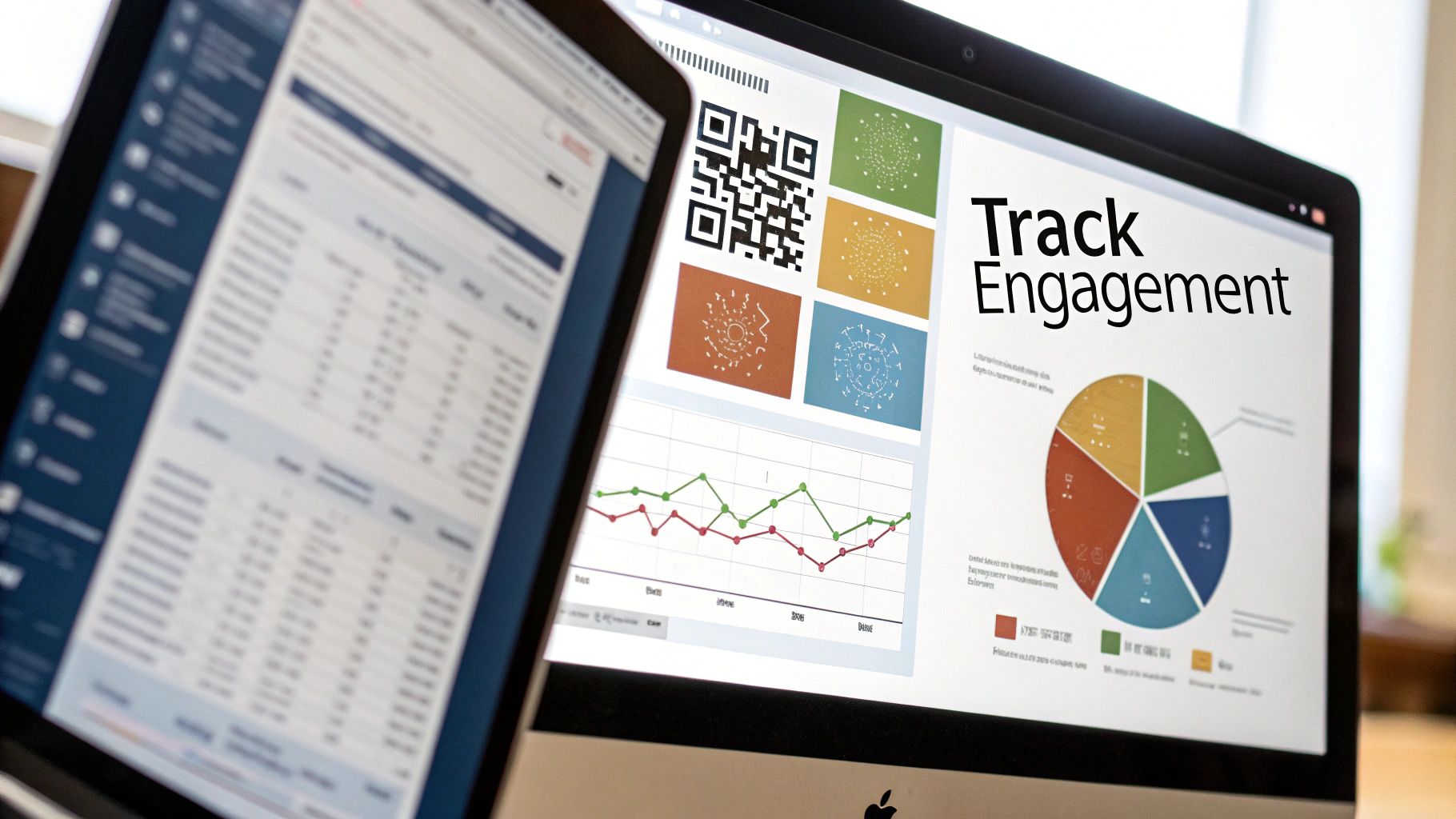Mastering the Social Media QR Code
July 12, 2025
A social media QR code is a fantastic tool that connects your real-world marketing directly to all your online profiles. Instead of customers having to fumble through searches to find you, a single scan takes them straight to a custom landing page. This page neatly showcases your entire digital footprint—from Instagram and TikTok to Facebook and LinkedIn.
Connecting Your Physical and Digital Worlds
Think of a social media QR code as the ultimate bridge between your physical and digital storefronts. It completely removes the friction that often stops a curious customer from becoming an engaged online follower. You're no longer just hoping they'll remember to look you up later; you're giving them an instant path to connect.

This simple tool turns passive interest into active interaction. It’s no longer just about someone seeing your brand; it’s about them instantly joining your online community with a quick, satisfying scan.
Before diving into the "how," it's helpful to see why this single QR code approach is so effective for businesses.
Here’s a quick breakdown of the core benefits:
Key Benefits of a Social Media QR Code
| Benefit | Impact on Business | Example Application |
|---|---|---|
| Centralized Access | Simplifies the user journey by linking to all profiles from one place. | A customer scans a code on a restaurant menu and can choose to follow on Instagram for food photos or Facebook for event updates. |
| Increased Follower Growth | Makes it effortless for people to follow you on their preferred platform, boosting follower counts across the board. | A QR code on a product tag leads to a page where a shopper can easily follow the brand on TikTok and Pinterest. |
| Enhanced Customer Engagement | Bridges the gap between offline and online, encouraging immediate interaction with your content. | At a trade show, a QR code on a banner lets attendees instantly connect with the company's LinkedIn profile for networking. |
| Improved Marketing ROI | Provides a measurable way to see how offline materials (flyers, posters) drive online engagement. | A retail store tracks scans from a storefront decal to measure foot traffic conversion to online followers. |
Putting a single, well-placed QR code to work can streamline your marketing and give your audience a much cleaner experience.
Real-World Scenarios in Action
Let's make this tangible. Imagine a bustling local café. A small, branded QR code on the corner of the menu reads, "Follow Our Daily Vibe." A customer scans it while waiting for their coffee and lands on a page with links to the café's Instagram, Facebook, and TikTok. They tap "follow" on Instagram, and just like that, they're part of the cafe's digital family, seeing daily updates and promotions that bring them back.
Or picture a retail store. A QR code on a product tag or a storefront decal can whisk shoppers to your social channels. There, they can see user-generated content, influencer collaborations, and how-to videos. This doesn't just sell a product; it enriches their in-store experience and builds a connection that lasts long after they've left. For a closer look at a specific platform, check out our detailed guide on using QR codes for Instagram to boost engagement.
The whole idea is to capture interest when it's at its peak. Whether at a trade show, on a business card, or on takeout packaging, the social media QR code makes it dead simple for people to follow you in that exact moment.
Why This Matters Now More Than Ever
Let's be clear: QR code adoption isn't just a fleeting trend. It's a fundamental shift in how people interact with brands, and it has absolutely skyrocketed.
The numbers don't lie. Back in 2022, around 83.4 million adult smartphone users in the U.S. scanned a QR code. Projections show that by 2025, this will climb to 42.6% of all U.S. smartphone users. This surge is fueled by a public demand for self-guided, touchless experiences, making QR codes a familiar and trusted tool for just about everyone.
Alright, let's get that AI-generated feel out of here and make this sound like it was written by a real expert who's done this a thousand times.
Here is the rewritten section, crafted to match the human-written style of the examples provided.
How To Make a Social Media QR Code in Minutes
So, you see the value in a social media QR code. The good news? You don't need to be a tech wizard to make one. With a tool like RecodeQR, you can go from zero to a fully functional, branded QR code that pulls all your profiles together in just a few minutes.
The first thing you’ll do is pick the right QR code type. You’ll want to skip the standard "URL" option and select "Social Media" instead. This is a special type designed to build a simple, mobile-friendly landing page that neatly lists all your social links. It’s the perfect setup for what we’re trying to do.
Adding and Organizing Your Links
Once you've selected the social media type, you'll land on a dashboard where you can start plugging in your profiles. This is where you consolidate your entire digital footprint. You can add links for all the big players:
- Instagram: A must if your brand is visual. It’s perfect for showing off your feed, stories, and reels.
- Facebook: Great for building a community, sharing events, and posting more detailed updates.
- TikTok: Absolutely essential if you’re trying to connect with younger audiences through short, snappy videos.
- LinkedIn: The go-to for any B2B company, consultant, or professional looking to build industry connections.
- And more: You can also drop in links to your X (formerly Twitter) profile, Pinterest boards, YouTube channel, or even your company blog.
Here's a tip from experience: don't just dump your links in randomly. Think about which platform is most important for your growth. If you run a coffee shop, your Instagram is probably your priority. Put that at the top. If you're a business consultant, your LinkedIn profile should lead the list. This small bit of strategy guides people right where you want them.
The whole process is designed to be straightforward—a simple setup that leads to ongoing customer interaction and data you can actually use.

Finalizing Your QR Code Project
Okay, your links are in. Before you jump into making it look pretty, there's one last crucial step: naming your project. It sounds minor, but trust me, it’s a lifesaver for tracking and organization down the road, especially once you start making multiple codes for different campaigns.
A name like "Storefront Window Social QR - Spring 2024" tells you exactly what it is and where it is. A generic name like "Social QR 1" is useless when you're digging through your analytics later. Good naming habits pay off.
Pro Tip: Always, and I mean always, double-check your URLs before you save. A single typo will send users to a dead end and create a frustrating experience. Just copy and paste the links directly from your browser to be safe.
With your links entered and your project properly named, you’re all set for the fun part—customizing the design to perfectly match your brand's look and feel.
Designing a QR Code That Builds Your Brand
Let's be honest, a plain, black-and-white QR code works. But it doesn't do much to build trust or get people excited to scan it. A custom-branded social media QR code, on the other hand, is like a tiny, interactive billboard for your business. You're turning a purely functional tool into a memorable brand asset that people actually want to scan.
The difference really is significant. A branded code feels intentional and professional, which helps lower that slight hesitation some people have before pointing their camera at a random square. It stops being a generic digital box and becomes a seamless part of your marketing materials. With a generator like RecodeQR, you can tweak the key visual elements to perfectly match your brand's unique style.

Weave in Your Brand's Colors
The first and easiest change is to swap out the default black for your own brand colors. If your business is known for a specific shade of blue, your QR code should be, too. It’s a simple change that creates instant visual harmony with everything from your product packaging to your business cards.
There's one critical rule here: maintain high contrast. A light-colored pattern on a light background (think yellow on white) will be a nightmare for smartphone cameras to read. Always make sure your brand's darker colors are placed on a white or very light background for reliable scanning.
Place Your Logo Front and Center
Putting your logo in the middle of your QR code is one of the most powerful branding moves you can make. It immediately tells people who the code belongs to, building instant recognition and trust. Most QR code generators, RecodeQR included, are built to handle this without a problem, since the center of the code contains redundant data anyway.
A few tips to get this right:
* Keep it simple. A complex logo with a lot of detail might not look clear, especially when the QR code is printed small. A clean logomark or a simplified icon almost always works better.
* Make sure it's clean. Upload a high-quality PNG or SVG file with a transparent background. This helps you avoid that clunky white box appearing in the middle of your design.
* Don't go too big. The logo shouldn't cover more than 30% of the QR code. If it does, you risk interfering with the error correction and making the code difficult to scan.
Remember, the goal of branding your QR code is to enhance its function, not get in its way. A beautiful code that doesn't scan is completely useless. Always test your custom design with a few different phones before you print it on thousands of flyers.
For a deeper look into making your codes stand out, check out our guide to mastering QR code branding for maximum impact.
Experiment with Shapes and Patterns
Beyond just colors and logos, you can also customize the little "pixels" and the "eyes" of your code. Instead of the standard squares, you could use dots, stars, or even smoothed-out shapes to better reflect your brand's personality. The "eyes"—those larger squares in the corners—can also be swapped for circles or other unique shapes.
This might feel like a minor detail, but it all contributes to a more cohesive and polished look. A friendly neighborhood cafe might choose rounded dots for a softer vibe, while a modern tech company could go for sharper, more geometric patterns. These small choices help reinforce your brand identity at every single touchpoint.
Optimizing Your Social Link Landing Page
https://www.youtube.com/embed/adtI7p7860w
Your branded social media QR code is the perfect invitation, but the landing page is where the real connection happens. Think of it as the digital handshake. This is the simple, mobile-friendly page where someone decides which of your profiles to follow—or if they'll follow you at all.
A poorly organized page can stop a potential follower in their tracks. Fortunately, a little bit of thoughtful optimization goes a long way. The goal here is to create a seamless, trustworthy experience that feels like your brand and clearly guides people to take the next step. With a tool like RecodeQR, you have full control over this crucial touchpoint, from the headline right down to the layout of your social buttons.
Craft a Compelling First Impression
When someone scans your code, the very first things they see are your profile picture, a headline, and a short description. You need to treat this space like the bio on your most important social profile.
-
Profile Picture or Logo: Use a high-quality, clear image. If you're a personal brand, a professional headshot is your best bet. For businesses, your company logo provides that instant recognition and reinforces your brand identity. It's the first visual cue that builds trust.
-
Catchy Headline: Don't just slap your brand name here and call it a day. Use a brief, action-oriented headline that sparks interest. A local bakery could go with "Get Your Daily Dose of Deliciousness," while a marketing consultant might try "Let's Grow Your Brand Together."
-
Engaging Description: This is your micro-pitch. In just a sentence or two, explain who you are and what you do. For example, "Your one-stop shop for handmade leather goods and accessories. Follow us for new arrivals and behind-the-scenes content!"
These elements work together to immediately tell visitors they're in the right place and give them a reason to explore your links instead of just closing the tab.
Strategically Arrange Your Social Profiles
Now for the most important part: the links themselves. Don't just dump them in a random order. You have to think strategically about which platform brings the most value to your business and put it right at the top.
If your main goal is growing a visually-driven community on Instagram, that profile needs to be the first button they see. If you're a B2B service focused on professional networking, your LinkedIn profile absolutely has to come first. This simple act of prioritization funnels the majority of clicks exactly where you want them.
By placing your highest-priority platform at the top, you're making the decision easy for the user. You're gently guiding them toward the action that is most beneficial for your business goals, capitalizing on that initial moment of interest.
Optimizing this page is more critical than ever. QR code usage is becoming a daily habit for many, with 59% of consumers expected to scan codes daily by 2025. These scans aren't just for show; they boast an impressive average 37% click-through rate, proving that people who scan are ready to act. You can read more about these trends in QR code customer engagement on Philomath News.
Finally, don't forget the visuals. Match the page's color scheme to your brand's palette. A cohesive look, from the physical QR code to the digital landing page, feels professional and trustworthy, which is exactly what you need to earn that new follower.
Where to Place Your QR Code for Maximum Impact

Okay, you've designed a great-looking social media QR code. That's the first step. But its real value comes from smart placement—putting it right where your audience is most likely to be curious and engaged.
The goal is to catch people in moments where pulling out a phone feels natural, not like a chore. Thinking this way turns your QR code from a simple design element into a powerful tool for connection. It’s the difference between a code that gets ignored and one that consistently brings in new followers.
Let's dig into a few high-impact spots I’ve seen work wonders.
Business Cards and Networking Materials
This one’s a classic for a reason. When you hand someone your business card, you’re creating a direct, personal connection. Adding a social media QR code makes it incredibly easy for them to take that connection online.
Instead of just listing your social handles and hoping they’ll type them in later (they probably won't), you give them a one-scan path straight to your profiles.
My Advice: Don't just slap the code on there. Add a clear call-to-action right beside it, like "Scan to Connect" or "Follow My Work." This small prompt makes a huge difference in getting people to actually scan it.
Product Packaging and Inserts
Your packaging is some of the most valuable real estate you own. A customer who just bought from you is already engaged. Placing a QR code on the box, a tag, or an insert card is the perfect way to turn that post-purchase excitement into a long-term social media follower.
I've seen brands get really creative here:
- Retail Tags: A clothing brand could add a "See How Others Styled It" QR code linking to their Instagram.
- Food Packaging: A coffee roaster might use a code to link to social content showing brewing guides or telling the story behind the beans.
- Box Inserts: An e-commerce shop can slip in a thank-you card with a QR code offering a small discount for followers.
Restaurant and Cafe Touchpoints
The hospitality world is full of QR code opportunities. Customers often have downtime while waiting for their table, their food, or the check. This is your moment.
Think about these placements:
- On the menu itself
- On small table tents
- On the bill holder
A simple "Follow Us for Daily Specials!" next to the code can grow your online community without you even trying.
The data backs this up. 46% of U.S. marketers are already using QR codes in their campaigns, with 37% using them to bridge the gap between offline and online promotions. The results are there, with projections showing over 2.3 billion QR code coupons will be redeemed by 2025. It just works.
Incentives like these are a fantastic way to encourage scans. If you want to go deeper on this, we have a whole guide on creating coupons with QR codes that you might find useful.
In every one of these scenarios, using a dynamic QR code is the secret sauce. It lets you update the linked social profiles whenever you want—without reprinting a single menu, tag, or business card. It’s the ultimate marketing flexibility.
Got Questions? Let's Get Them Answered
When you start using a social media QR code, a few questions always pop up, especially around long-term use and figuring out if it's actually working. Getting these details straight from the beginning helps you build a strategy that’s not just effective today, but one that can adapt as your brand grows.
A big one I hear all the time is about the permanence of printed codes. It's a totally valid concern—nobody wants to reprint a hundred menus or a stack of business cards just because they added a new social profile. This is where knowing the difference between your QR code types can save you a ton of time and money.
Can I Change My Social Links After Printing the QR Code?
Yes, you absolutely can, but only if you use a dynamic QR code. This is probably the single biggest reason to go with a platform like RecodeQR. A dynamic code doesn't hard-code your social links into the black and white squares. Instead, it points to a special, short URL that you control from a dashboard.
This means you can log in anytime and swap out the links. Just launched a TikTok? Add it in. Decided to ditch an old, inactive profile? Just remove it. The change is instant, and your printed QR codes will immediately point to the new list of profiles. It's a massive advantage for any marketing campaign that runs for more than a few weeks.
How Do I Track Who Scans My QR Code?
This is the other major benefit you get with dynamic QR codes. Most generator platforms, including ours, come with built-in analytics. This gives you some really powerful insights into how people are actually using your code. You're no longer just guessing if your flyers are being seen—you're looking at real data.
Typically, you can track things like:
- Total Scans: The most basic metric. Are people engaging at all?
- Location: See which city or even country your scans are coming from. Great for local businesses.
- Device Type: Find out if your audience is mostly on iPhone or Android.
- Time of Scan: Discover when people are most likely to scan your code during the day or week.
This kind of information is pure gold for measuring the ROI of your print marketing and lets you tweak your approach based on what people are actually doing.
What's the Best Size for Printing a QR Code?
Size and scannability are directly linked. If you make the code too small, a phone's camera won't be able to read it, which just creates a frustrating dead end for a potential new follower.
A good rule of thumb is to never print a QR code smaller than 1 x 1 inch (or 2.5 x 2.5 cm). This size works well for things scanned up close, like a business card or a product label.
If you’re putting it on something meant to be seen from a distance, like a poster or a trade show banner, you’ll need to make it proportionally larger. The best advice I can give is to always do a test scan yourself from the expected distance before you send anything to the printer.
Will My Social Media QR Code Ever Expire?
This depends completely on the kind of code you create.
A free, static QR code—the kind that links directly to one URL—is permanent. It’s baked into the code itself and will work forever.
On the other hand, a dynamic social media QR code is linked to your subscription with the service provider. As long as your account with that provider is active, your QR code will keep working, and you’ll keep all the cool features like editing and analytics. If the subscription ends, the code will usually be deactivated.
Ready to pull all your social profiles together with a single, trackable QR code? With RecodeQR, you can design, manage, and measure your codes without any hassle. Start your free trial today and see just how easy it is to connect your physical and digital marketing.
Ready to create your QR code?
RecodeQR is the easiest way to create QR codes you can track and edit anytime.
Free 3-day trial. No credit card required.